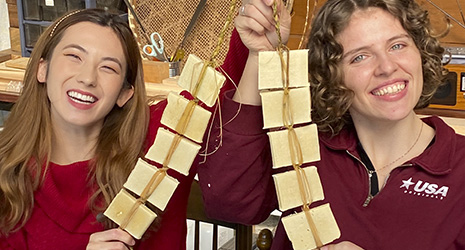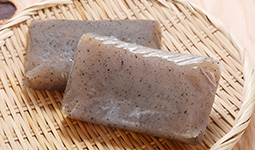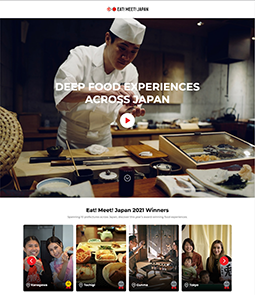June 2022
- English
- 日本語
An Ambassador for Japanese Food

Shizuka Anderson (left) and Ellie Fox (right) hold strings of shimi-dofu (freeze-dried tofu) in Chino City, Nagano Prefecture 
Anderson (right) at a ramen establishment in Tokyo with two fellow EMJ Ambassadors, Bunnytokyo (center) and Donny Kimball (left)

Anderson (left) and Leina Bambino (right) look at the local specialty iwagaki rock oysters in Maizuru City, Kyoto Prefecture, facing the Sea of Japan 
konnyaku 
Home page of the “Japan by Food” online channel
https://www.youtube.com/
c/JapanbyFood?app=desktop
Home page of the “EAT! MEET! JAPAN” official site
https://eatmeetjapan.co

Shizuka Anderson, an “EAT! MEET! JAPAN Ambassador” from Canada, has been promoting the appeal of Japanese cuisine around the world, mainly through online video sharing platforms.

The Ministry of Agriculture, Forestry and Fisheries (MAFF) of the Japanese government is implementing the “EAT! MEET! JAPAN” project (https://eatmeetjapan.co) in order to foster an environment in which visitors from other countries have the opportunity to partake in a wide range of food experiences during their stay in Japan and experience Japanese food again once they have returned home. A key element of the initiative is disseminating information to other countries. The project delivers various food experiences in English through social media, including eating Japanese food as well as cooking and harvesting. Four EAT! MEET! JAPAN Ambassadors (hereinafter, EMJ Ambassadors) play a key role in this initiative. Shizuka Anderson from Edmonton, Canada is one of them.

https://eatmeetjapan.co
Anderson came to Japan, her mother’s home country, at the age of 18 to study at Sophia University in Tokyo. Her career in the entertainment industry began when she was chosen to host a children’s television program while still in college. Since then, she has worked in a variety of media, including television, radio, and film, as a model, actor, singer, and reporter. Including in her role as an EMJ Ambassador since 2021, Anderson has been expanding the scope of her work in the past few years to reporting on Japanese food, primarily on online video sharing platforms.
Anderson introduces a wide variety of cuisines, ranging from typical Japanese food such as sushi and tempura, to regional dishes from all over the country. One of the online channels where Anderson broadcasts her reports is “Japan by Food,” where she demonstrates her gift for expressing the qualities and appeal of the various Japanese dishes with expertise and precision. This may well be why so many people have commented on the videos, “I can’t wait to visit Japan and try it for myself!”

“I don’t think ahead about what I’m going to say when I’m eating. My approach is to communicate honestly and clearly about how I felt when I ate the dish,” says Anderson. “Many overseas viewers have limited experience of Japanese food, so I use examples of foods they are familiar with when describing flavors and textures.”
One food that Anderson struggled to describe was konnyaku. Manufactured from the bulb of the konjac plant, konnyaku itself has little flavor but a distinctive texture. It is a common ingredient in Japanese dishes such as oden (a one-pot dish of simmered ingredients) and miso soup, but is not widely known outside of Japan. “Jiggling like jelly, but more chewy than jelly,” is how she describes its consistency.

Japan’s regional areas in particular are a veritable treasure trove of such unique ingredients and culinary delights. One such dish that made an impression on Anderson recently is shimi-dofu, or freeze-dried tofu. The traditional method of making shimi-dofu involves freezing and drying tofu outside in the extreme cold of winter. In February 2022, Anderson visited Chino City, Nagano Prefecture, as an EMJ Ambassador, where she enjoyed making shimi-dofu and preparing local shimi-dofu dishes. While there, she was struck by the resourcefulness of Chino City locals who take advantage of the cold, dry climate during the winter months when the agricultural harvest is scarce to make shimi-dofu.

https://www.youtube.com/c/JapanbyFood
Anderson says, “A profound love for food permeates Japan’s regions, where many processed foods and dishes created from local specialties such as vegetables, fruits, and shellfish have been handed down through the generations. The abundance of truly great food is the result of an uncompromising commitment to each individual ingredient and a rigorous devotion to traditional methods of production.”
One of Anderson’s goals now is to earn a qualification as a “beer sommelier.” While numerous varieties of beer are sold by major corporations, in recent years many areas of Japan have been producing their own craft beer.
“I’m a huge fan of Japanese beer so I want to explore how craft beers from different regions can complement Japanese cuisine,” says Anderson. “I hope to continue to share the appeal of Japan’s diverse and fascinating food culture with people around the world.”
EMJ Ambassadors continue to close the distance between Japan and the rest of the world through food.

